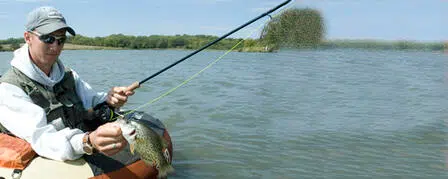
Does the use of live-imaging sonar impact fishing results to the point where it’s no longer fair, either for anglers who don’t use the technology or the fish themselves?
The question prompted the Kansas Department of Wildlife and Parks to create a study for answers. Fisheries biologist Ben Neely says the live-imaging sonar looked at “when an advancement is too advanced.” With no other data available and other states having the same concerns, Wildlife and Parks struck out on its own to create the study.
The study took place in December, when over 30 people from the Wildlife and Parks Fisheries and Wildlife divisions, Kansas State University and a few volunteers went to Cedar Bluff Reservoir as part of a two-week experiment. Anglers were randomly partnered and told to fish for seven hours, either on the north or south side of the lake and either with or without the use of the live-imaging sonar. Each team then switched sides and equipment use the following day, resulting in 16 controlled samples for the study. Neely says the results didn’t show much in the way of statistical differences, and as such doesn’t violate “fair chase” ethics for casual anglers.
Besides there not being much difference in the number of crappie caught, there wasn’t much difference in the size of fish being caught. Fish caught by anglers using live sonar were slightly longer and heavier than fish caught by anglers not using the technology.
Neely says the study took several months to create, and he says the one uncontrolled factor in the study was angler skill and ability — so the study tried to replicate the experience of the “casual weekend angler.” Neely says crappie was the focus, but anglers in the study also caught “a lot” of white bass caught, along with largemouth bass, spotted bass, walleye, bluegill, freshwater drum and wipers.
Neely says there is still a question about the use of live-imaging technology by expert anglers. Wildlife and Parks is considering a separate study to understand how the technology impacts experienced users, and Neely says there is a possible study coming about whether the use of live sonar will increase fish harvest along with efficiency. A separate study could well be coming on the sociology behind fishing technology — and a similar study to the one recently conducted on crappie is coming for blue catfish later this year.
"fish" - Google News
March 13, 2022 at 08:16PM
https://ift.tt/Ts8XwKa
Wildlife and Parks study shows slightly more, bigger fish caught through use of live-imaging sonar, but not at unfair levels - KVOE
"fish" - Google News
https://ift.tt/NMeTVLD
https://ift.tt/WwVh4lD
Bagikan Berita Ini
















0 Response to "Wildlife and Parks study shows slightly more, bigger fish caught through use of live-imaging sonar, but not at unfair levels - KVOE"
Post a Comment